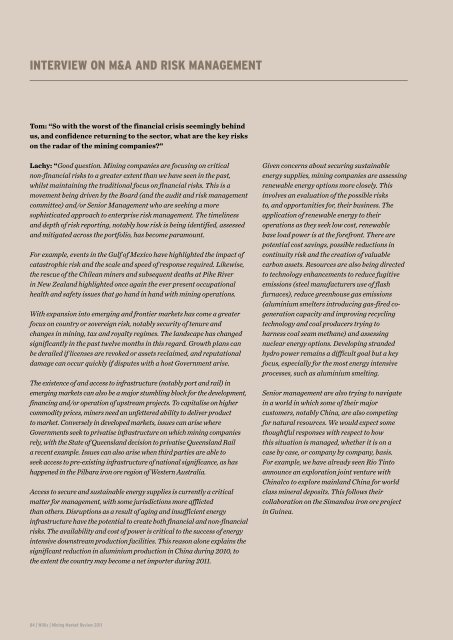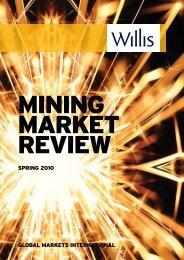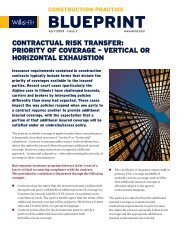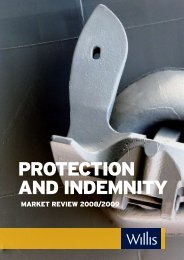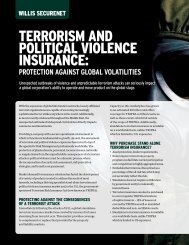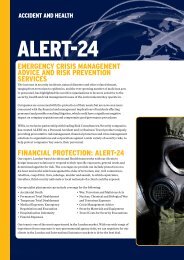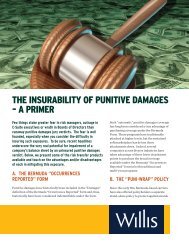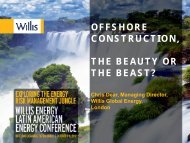spRING 2011 GlobAl MARKETs INTERNATIoNAl - Willis
spRING 2011 GlobAl MARKETs INTERNATIoNAl - Willis
spRING 2011 GlobAl MARKETs INTERNATIoNAl - Willis
You also want an ePaper? Increase the reach of your titles
YUMPU automatically turns print PDFs into web optimized ePapers that Google loves.
InterVIew on m&a and rIsk management<br />
Tom: “So with the worst of the financial crisis seemingly behind<br />
us, and confidence returning to the sector, what are the key risks<br />
on the radar of the mining companies?”<br />
Lachy: “Good question. Mining companies are focusing on critical<br />
non-financial risks to a greater extent than we have seen in the past,<br />
whilst maintaining the traditional focus on financial risks. This is a<br />
movement being driven by the Board (and the audit and risk management<br />
committee) and/or Senior Management who are seeking a more<br />
sophisticated approach to enterprise risk management. The timeliness<br />
and depth of risk reporting, notably how risk is being identified, assessed<br />
and mitigated across the portfolio, has become paramount.<br />
For example, events in the Gulf of Mexico have highlighted the impact of<br />
catastrophic risk and the scale and speed of response required. Likewise,<br />
the rescue of the Chilean miners and subsequent deaths at Pike River<br />
in New Zealand highlighted once again the ever present occupational<br />
health and safety issues that go hand in hand with mining operations.<br />
With expansion into emerging and frontier markets has come a greater<br />
focus on country or sovereign risk, notably security of tenure and<br />
changes in mining, tax and royalty regimes. The landscape has changed<br />
significantly in the past twelve months in this regard. Growth plans can<br />
be derailed if licenses are revoked or assets reclaimed, and reputational<br />
damage can occur quickly if disputes with a host Government arise.<br />
The existence of and access to infrastructure (notably port and rail) in<br />
emerging markets can also be a major stumbling block for the development,<br />
financing and/or operation of upstream projects. To capitalise on higher<br />
commodity prices, miners need an unfettered ability to deliver product<br />
to market. Conversely in developed markets, issues can arise where<br />
Governments seek to privatise infrastructure on which mining companies<br />
rely, with the State of Queensland decision to privatise Queensland Rail<br />
a recent example. Issues can also arise when third parties are able to<br />
seek access to pre-existing infrastructure of national significance, as has<br />
happened in the Pilbara iron ore region of Western Australia.<br />
Access to secure and sustainable energy supplies is currently a critical<br />
matter for management, with some jurisdictions more afflicted<br />
than others. Disruptions as a result of aging and insufficient energy<br />
infrastructure have the potential to create both financial and non-financial<br />
risks. The availability and cost of power is critical to the success of energy<br />
intensive downstream production facilities. This reason alone explains the<br />
significant reduction in aluminium production in China during 2010, to<br />
the extent the country may become a net importer during <strong>2011</strong>.<br />
| <strong>Willis</strong> | Mining Market Review <strong>2011</strong><br />
Given concerns about securing sustainable<br />
energy supplies, mining companies are assessing<br />
renewable energy options more closely. This<br />
involves an evaluation of the possible risks<br />
to, and opportunities for, their business. The<br />
application of renewable energy to their<br />
operations as they seek low cost, renewable<br />
base load power is at the forefront. There are<br />
potential cost savings, possible reductions in<br />
continuity risk and the creation of valuable<br />
carbon assets. Resources are also being directed<br />
to technology enhancements to reduce fugitive<br />
emissions (steel manufacturers use of flash<br />
furnaces), reduce greenhouse gas emissions<br />
(aluminium smelters introducing gas-fired cogeneration<br />
capacity and improving recycling<br />
technology and coal producers trying to<br />
harness coal seam methane) and assessing<br />
nuclear energy options. Developing stranded<br />
hydro power remains a difficult goal but a key<br />
focus, especially for the most energy intensive<br />
processes, such as aluminium smelting.<br />
Senior management are also trying to navigate<br />
in a world in which some of their major<br />
customers, notably China, are also competing<br />
for natural resources. We would expect some<br />
thoughtful responses with respect to how<br />
this situation is managed, whether it is on a<br />
case by case, or company by company, basis.<br />
For example, we have already seen Rio Tinto<br />
announce an exploration joint venture with<br />
Chinalco to explore mainland China for world<br />
class mineral deposits. This follows their<br />
collaboration on the Simandou iron ore project<br />
in Guinea.


